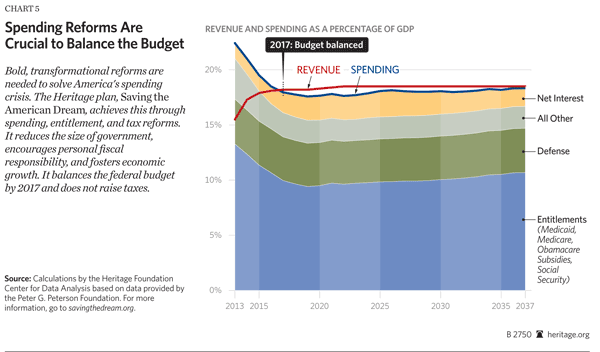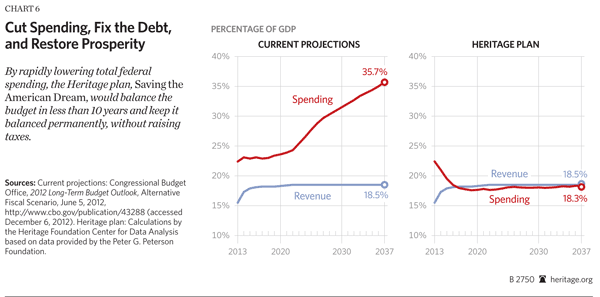Abstract: Unless Congress and the President act promptly and wisely, sequestration under the Budget Control Act (BCA) will undermine military readiness, and the nearly $500 billion tax increase starting on January 1, 2013, will greatly harm an already weak economy. However, this fiscal cliff can be avoided. The key to avoiding this and future fiscal calamities is reform of the mandatory spending programs, from welfare to Social Security, that currently drive federal deficits. The Heritage Foundation’s Saving the American Dream plan would rein in spending immediately, restructure the major entitlement programs to bring entitlement spending under control over the long term, and strengthen the core foundations of these programs.
Since the Heritage Foundation’s Saving the American Dream plan[1] was first published in April 2011, there has been almost no substantive progress on spending control. The only plausible exception was the flawed Budget Control Act (BCA), a product of a contentious debt limit debate. The complete failure of the resultant bipartisan “supercommittee” to reach agreement was a sad reflection on a Congress that is divided and unwilling to pass the legislation necessary to rein in spending.
As a result, the nation is facing the looming sequester, which will further undermine the defense budget, jeopardizing one of the federal government’s core constitutional responsibilities. Yet it would leave entitlement programs virtually untouched, even though they are the largest driver of spending today and in the future. Meanwhile, the prospect of a huge tax increase in January has had a deleterious effect on the economy for many months, although the effect is only a small portion of the harm the economy will incur if the tax increase ultimately takes effect. America seriously needs a true way forward.

The Heritage plan reflects the need to rein in spending immediately and to rethink major programs. Spending on the open-ended Social Security, Medicare, and Medicaid entitlements must be brought under control, and the core foundations of these programs should be strengthened.
The following principles guide the policy solutions in Saving the American Dream:
- Total spending must be brought under control to balance the budget without raising taxes, ultimately holding revenues at their historical share of gross domestic product (GDP).
- Entitlement programs should, unlike today, actually guarantee seniors economic security in retirement and be recast as real and sustainable insurance programs focused on those who truly need them.
- Other spending must be curbed, and the federal government must be restricted to its proper functions.
- Defense, as a core constitutional function of the federal government, should be fully funded and efficiently delivered.
- The tax system should be structurally reformed to foster growth by eliminating tax distortions of private economic decisions, especially decisions on savings and investment, and to make the system simpler and more transparent.
Priorities for Congress and the President
Fiscal year (FY) 2012 closed on September 30 with the Congressional Budget Office (CBO) estimating spending of $3.5 trillion and a deficit of $1.1 trillion.[2] Debt held by the public was $11.3 trillion (73 percent of GDP). According to the CBO, debt will explode to 199 percent of GDP by 2037, driven by growth in spending that will reach 36 percent of GDP.[3]
The main drivers of spending and debt increases are incontrovertibly the major entitlement programs: Social Security, Medicare, and Medicaid. However, the slow economy with its high unemployment rate, which remains stuck at around 8 percent, also adds to deficits and debt through two channels: mandatory spending for those workers who are most affected by the slow economy (e.g., unemployment compensation) and below-average tax revenues.
It is clear that the top priorities for Congress and the President should be controlling spending, especially entitlement reform, and setting an economic growth agenda through tax reform. After averting the fiscal cliff, Congress and the President should immediately turn their attention to these pressing issues.
As noted, entitlements are the fastest-growing programs. Even if all other spending was eliminated, these programs would still cause large and unsustainable deficits in the future. Their growth is automatic, with autopilot spending increases built in and no serious budgetary constraints. The top priority must be to restructure entitlements and put a brake on their spending levels while strengthening and preserving them for future generations.
A number of robust proposals for health care reforms already exist, both in Congress and in the policy community.[4] Congress and the President should take advantage of this policy momentum and focus on reforming Medicaid and especially Medicare. However, changes in Social Security should follow quickly, and the rules that govern these programs in general should be more consistent. For example, increases in the normal eligibility age should proceed simultaneously for both Social Security and Medicare.
Specific steps for Congress and the President include the following:
- The President should submit a budget by the 2013 tax deadline deadline that outlines strong, sweeping changes in entitlement programs that will reduce spending over the 10-year budget window and significantly improve the long-term trajectory of these programs.
- The President’s budget should lay out specific goals for a pro-growth, revenue-neutral tax reform plan.
- Congress and the President should include reforms in entitlement programs and further reductions in other spending areas, including the Patient Protection and Affordable Care Act (Obamacare), in exchange for any increases in the debt limit. These should reflect lessons learned from the 2011 Budget Control Act, such as avoiding high-stakes mechanisms like sequestration that are designed to fail.
- Congress should pass a joint budget resolution by the April 15, 2013, deadline that includes reconciliation instructions for entitlement and tax reform.
- The budget resolution should also require reforms of other spending programs to bring spending below the BCA levels for 2014 and beyond.

Health Care
If only one issue is thoroughly addressed in 2013, it should be the federal role in health care, the biggest driver of spending. The flawed Obamacare law only adds to the problem. Instead of expanding the government’s role, health care should follow a true patient-centered, market-based model, including reforms in Medicare, Medicaid, and the tax treatment of health insurance.
Medicare. Medicare’s finances must be brought under control. As a first step, the age of eligibility should be raised gradually from 65 to 68 and then indexed to life expectancy. Premiums for Parts B and D should also gradually increase, thus expanding the current policy for Medicare of adjusting the level of taxpayer subsidies to income, with the most affluent seniors receiving much smaller (or in some cases no) taxpayer subsidies for their health coverage. These steps, among others,[5] should occur immediately because they are easily achieved and less controversial and should be part of new debt-limit legislation.
Within five years of these initial changes, patients should also be transitioned to a defined-contribution or premium-support model that would be adjusted for income. Expanding competition in Medicare would restrain federal spending, slow health care costs, and promote greater innovation in the delivery of care.[6]
Medicaid. Federal spending on Medicaid should be put on a budget subject to regular congressional review to bring greater fiscal certainty and stability to the process. Federal Medicaid spending would follow antipoverty spending caps by reverting to the 2007 spending levels when the economy approaches full employment (e.g., the unemployment rate dips below 6 percent) and be adjusted for medical inflation thereafter.
In lieu of traditional Medicaid, able-bodied individuals and families should receive direct federal assistance in the form of tax credits or direct assistance to enable them to buy private insurance coverage of their choice. For the disabled and frail elderly, Medicaid would remain a joint federal–state safety net program, but states would have additional flexibility to adopt more patient-centered models.
Reform of the Tax Treatment of Health Insurance. As a part of tax reform (see below), the employee tax break for employer-sponsored coverage would be converted to a non-refundable tax credit that individuals and families could use to purchase the health plan of their choice.
These larger reforms are best achieved through normal legislative order. This could include the legitimate use of reconciliation as part of a comprehensive budget plan. In any case, Congress should pass a concurrent budget resolution for FY 2014.
Social Security
Social Security needs to be reformed. It is running permanent cash-flow deficits and has severe programmatic flaws.[7]
First, Social Security’s eligibility age should gradually be increased in tandem with Medicare’s eligibility age. For both, this change is straightforward and could be included in an initial, small reform package. Next, Social Security should return to its original purpose of guaranteeing that all Americans are protected from poverty in retirement. As part of this insurance protection, benefits would evolve to an understandable, predictable flat benefit that is well above the poverty level. With Social Security functioning as an insurance program, moderate-income retirees would receive a smaller check, while affluent seniors would receive no check unless their financial circumstances change.
To encourage people to stay in the workforce longer, those who work beyond full retirement age would receive a higher level of after-tax income until they do retire.

Tax reform would support Social Security reforms by significantly increasing personal savings that seniors can take into retirement, and there would be no limit on the amount of these tax-deferred savings. Thus, more retirement income would be possible than under the current system. Social Security would become a safety valve against economic reversals and a floor for income after the statutory retirement age.
Other Spending
Defense cuts are already reducing military readiness, thus endangering the security of the United States. The defense portion of the BCA cuts is dangerously flawed and must be reversed. In Saving the American Dream, the sequester for defense spending (including the 2013 cuts) is eliminated, and the higher spending is more than offset with reforms in other spending and entitlements. Defense spending is brought slowly up to and held at 4 percent of GDP. Non-defense discretionary spending is set for 2013 at the BCA sequester level and then reduced to 2 percent of GDP, after which it is indexed to inflation.
Spending in 2014 and beyond should include reforms in long-standing but growing and expensive programs such as farm subsidies and transportation. A program of privatization, including federal asset sales, could begin as early as 2015. Anti-poverty spending should be rolled back and capped when the economy approaches full employment and then consolidated into fewer programs that reflect strong incentives for work and marriage.
Revenue
Tax Reform. The economy remains plagued by the uncertainty of expiring tax policy and an unwieldy and inefficient tax code. Beyond preventing Taxmageddon by extending all current tax policy and delaying the Obamacare tax increases before January 1, 2013, Congress should pass broad substantive tax reform consistent with the New Flat Tax in Saving the American Dream. Tax reform should focus on promoting economic growth by reducing both tax rates and tax distortions while maintaining revenue and distributional neutrality. It should also simplify the tax system and improve its transparency so that taxpayers can better understand the influence of tax policy as well as the true cost of government.[8]
The broad direction for tax reform already in play, especially the bipartisan push for lower corporate income tax rates, is fully consistent with the New Flat Tax. Congress will likely find the goal of lower corporate tax rates quickly running up against the consequent need to lower tax rates for non-corporate businesses. This occurs naturally under the New Flat Tax, which taxes all businesses at a single rate on their domestic net cash flow at the entity level. Likewise, the growing support for a territorial tax system—under which U.S. businesses are taxed solely on their domestic income—is also fully consistent with the New Flat Tax, which levies tax solely on domestic income.
Under the New Flat Tax, the individual income tax and the payroll tax are rolled into one system with the same tax rate that is imposed on business income. Nearly all other federal levies are repealed, leaving a simple system for both individuals and businesses. Under the New Flat Tax as it applies to individuals, only income used for consumption is taxed, thus eliminating the existing tax bias against saving. In addition, all distorting credits, exemptions, and deductions are eliminated, leaving only two credits and three deductions.
The first credit is the above-mentioned tax credit for health insurance. This tax credit is less distortive of economic decisions than current law is, but it remains a clear subsidy for the purchase of health insurance. It is necessary because the current-law tax bias favoring health insurance is so powerful and so entrenched that simply eliminating the tax advantage is impracticable.
The second credit carried over from current law is the earned income credit (EIC). The EIC needs reform in its own right, but it is also the largest income-support component of the overall federal anti-poverty program and one of its most effective elements. Changes in the EIC should then be considered part of the proposed budget for anti-poverty programs.
The three deductions are as follows:
- The deduction for charitable expense, which is retained because this tax system taxes the individual on what he or she spends. Charitable contributions benefit the receiving organization and thus should be deductible for the recipient.
- A deduction for higher education, which recognizes that education expenses are a form of saving and investing simultaneously, which in every other instance is excluded from tax under the New Flat Tax.
- An optional home mortgage deduction with the proviso that if the homeowner chooses a mortgage with deductible interest, then the lender must, as under current law, continue to pay tax on interest income earned. Alternatively, the home owner may choose to forgo the deduction, in which case the lender earns tax-free interest income and can thus charge a lower mortgage interest rate.
The New Flat Tax, the tax reform plan, is implemented effective January 1, 2014.

Addressing the Fiscal Cliff
Table 1 addresses each element of the fiscal cliff and the proposed steps that Congress should take on each of them.
—Alison Acosta Fraser is Director of the Thomas A. Roe Institute for Economic Policy Studies, William W. Beach is Director of the Center for Data Analysis and Lazof Family Fellow in Economics, and Stuart M. Butler, PhD, is Director of the Center for Policy Innovation at The Heritage Foundation.
The editors are grateful to the team leaders who worked with policy experts throughout The Heritage Foundation to develop this report: J. D. Foster, Ph.D., Norman B. Ture Senior Fellow in the Economics of Fiscal Policy; Rea S. Hederman, Jr., Assistant Director and Research Fellow in the Center for Data Analysis; David C. John, Senior Research Fellow in Retirement Security and Financial Institutions; Robert E. Moffit, Ph.D., Senior Fellow in the Center for Policy Innovation; Nina Owcharenko, Director of the Center for Health Policy Studies; and Drew Gonshorowski, Policy Analyst in the Center for Data Analysis.
This plan was developed as part of the Solutions Initiative and funded by the Peter G. Peterson Foundation. The Peterson Foundation convened organizations with a variety of perspectives to develop plans addressing our nation’s fiscal challenges. The American Action Forum, Bipartisan Policy Center, Center for American Progress, Economic Policy Institute, and The Heritage Foundation, each received grants. All organizations had discretion and independence to develop their own goals and propose comprehensive solutions. The Peterson Foundation’s involvement with this project does not represent endorsement of any plan.





